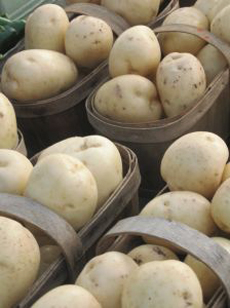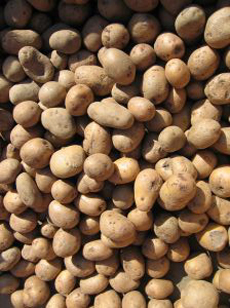
Freshly-dug potatoes. Now, how do you store them? Photo by Alistair Williamson | SXC
|
MALLIKA RAO is an intern at THE NIBBLE. |
|
November 2010
Last Updated September 2018
|
 |
How To Store Potatoes
Page 3: How To Buy Potatoes
This is Page 3 of a seven-page article, including a Potato Glossary. Here, how to buy and store potatoes. Click on the black links below to view other pages.
| Article Index: |
Potato Glossary: |
|
|
How To Buy Potatoes
When buying potatoes, choose ones that are firm with smooth skin.
-
Avoid potatoes that are too soft, greenish in color or have cuts, sprouts or blemishes. These are more likely to be bitter, and green-tinged potatoes and those that are sprouting can even be toxic.
-
Choose potatoes that are uniform in size, so that they will take the same amount of time to cook when you prepare them.
-
As with many other foods, potatoes are cheaper when you buy more of them. If you think a large-bag will be more than you can use, expand your potato repertoire: not just as a side dish but potato soup, potato pancakes and the always-popular potato salad.
How To Store Potatoes
Potatoes can bruise easily and should be stored in dark, dry, cool places. Potatoes don’t go bad quickly, and can be stored for up to 6 months.
-
Don’t store potatoes in airtight plastic bags. If they are sold in plastic, the bag should have cut-outs to enable breathing.
- If storing potatoes in paper bags, leave the bags open at the top to allow for easy breathing.
-
Shield potatoes from light. When exposed to light, potatoes become green-tinged, which is a sign of chlorophyll and toxic alkaloids.
-
Don’t store potatoes near onions. Proximity to onions causes potatoes to sprout more quickly.
-
Don’t store raw potatoes in the refrigerator. When stored at temperatures below 40°F, the starch converts to sugar, and the moisture will cause sprouting.
Cooking With Potatoes
Leave Skins On. Potatoes are easier to prepare and healthier to eat when their skins are left on.
Soak & Scrub. Potatoes are typically washed before they are shipped to be sold, but should be washed again before food preparation.
- Soak potatoes in cool water to loosen the dirt; then scrub them gently with a vegetable brush or sponge.
- Trim away any eyes or blemishes. Make sure you remove any the green parts and cut areas.
Don’t Freeze. Freezing cooked potatoes is usually not a good idea. Since potatoes are 80% water, they become watery and grainy when reheated. Manufacturers of prepared potatoes have methods to circumvent this, but a home freezer can’t.
|
|

A bin of potatoes. Photo by Christa Richert | SXC.
|
- When freezing a dish that requires potatoes, it is best to exclude them when freezing, and throw them in afterwards.
Potato Nutrition
While perhaps best known for its carbohydrate content (approximately 26g in a medium potato), potatoes are nutritious: low in fat and high in vitamin C. They also contain iron, potassium, magnesium and antioxidants. The skin is the most nutrient-rich part of the potato: learn to enjoy it (we love the crispy skin of an oven-baked potato).
Because potatoes are high in carbohydrate, there is a misconception that they are fattening. However, the calories come from other ingredients with which the potatoes are prepared—butter and cooking oil, sour cream and gravy.
- A medium baked potato has 161 calories. Skip the butter and sour cream and season with nonfat plain Greek yogurt, fresh-cracked pepper and snipped chives. It’s just as delicious and you’ve only added 20 more calories.
Take a look at the nutrition in a potato. The nutrients are about evenly divided between the flesh and the skin: a good reason to keep the skin on!
| Nutrient & % RDA |
Without Skin |
With Skin |
| Vitamin C |
33% |
28% |
| Vitamin B6 |
23% |
27% |
| Potassium |
17% |
26% |
| Copper |
17% |
10% |
| Niacin |
11% |
12% |
| Thiamin |
11% |
7% |
| Magnesium |
10% |
12% |
| Dietary Fiber |
9% |
15% |
| Pantothenic Acid |
9% |
7% |
| Folate |
4% |
12% |
| Iron |
3% |
10% |
Data from Nutritiondata.com for the percent RDA
(Recommended Daily Value) provided by a medium
potato.
Continue To Page 4: Potato Glossary A & B
Go To The Article Index Above
|





